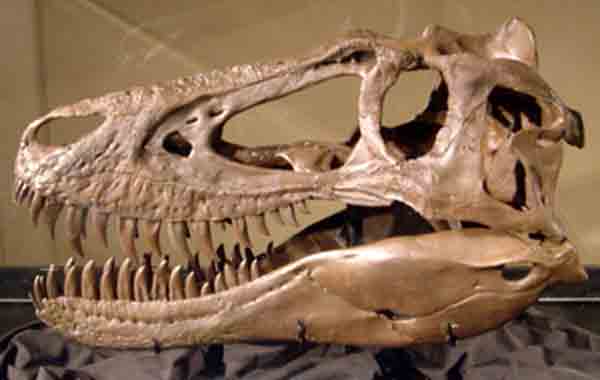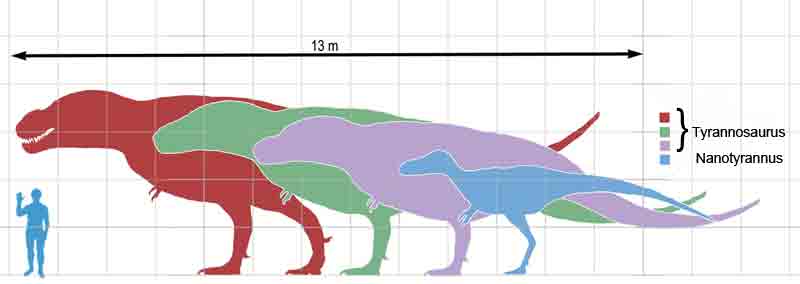Fossil Dinosaur Tooth mm 19 x 11 x 7 Tyrannosaurus T-rex Nanotyrannus lancensis Theropod Bipedal Carnivore Extinct Reptiles Mesozoic Cretaceous Collecting Paleontology Museum.
Distal end, very beautiful priceless high quality fossil specimen detailed, with wonderful looking serration. Not restoration at all. Only a piece, as in photos.
The Nanotyrannus (Saurischia, Theropoda, Carnosauria, Tyrannosauridae, Tyrannosaurinae), whose name means "tyrant dwarf" or "little tyrant", is a genus of the family of tyrannosaurids, lived in the Upper Cretaceous about 70-65 million years ago in that that today is North America. It is known only for two specimens (maybe three), including a small skull about 1.2 m long, similar in shape to the well-known Tyrannosaurus, but with a more elongated and vertically compressed shape, with a greater number of teeth compared to aa Tyrannosaurus, discovered by Charles W. Gilmore in 1942 and described in 1946 as a model of Gorgosaurus lancensis (now known as Albertosaurus). In 1988, the sample was again described by Robert T. Bakker and colleagues, based on the skull bones which, being fused, therefore belonged to an adult specimen.

In light of this, they assigned the skull to a new genus, called Nanotyrannus for its apparent small dimensions. However new doubts arose about it, and some paleontologists do not consider it a valid genre, since the animal was a contemporary of Tyrannosaurus rex, and therefore they consider it a juvenile T. rex.
After the discovery in 2001 of a new specimen of Nanotyrannus, nicknamed "Jane", based on the skeleton of the specimen, it was calculated that the animal had to reach a length of about 6.50 meters, with a height of 2 meters, for a weight ranging between 600 kg and 900 kg, far less than the weight one would expect from a young Tyrannosaurus. The long legs and big feet of the animal indicated that the animal was a great sprinter capable of reaching a speed of 30-50 kilometers per hour, making it one of the fastest animals in its ecosystem. Regardless of whether the specimens on issues are a new species or juvenile Tyrannosaurus specimens, paleontologists think that the animals in life were covered by a more or less extensive layer of feathers or protophane.
Among the main differences that paleontologists in favor of Bakker's theory on which the Nanotyrannus would represent a separate species from Tyrannosaurus, are the number of teeth. The Nanotyrannus possessed many more teeth in its jaws, counting as many as 14-15 teeth on each side of the upper jaw and 16 teeth on each side of the lower jaw. On the other hand, the Tyrannosaurus had 11-12 on each side of the upper jaw and 11-14 on the lower side. The exact implications of this difference in the number of teeth is very controversial. In a 1999 study on tyrannosauride growth patterns, paleontologist Carr showed that, in Gorgosaurus libratus, the number of teeth decreased with the growth of the animal and used this data to support the hypothesis that the Nanotyrannus was only a young specimen of T. rex. However, this hypothesis was denied and discredited by careful research on the growth patterns of Tarbosaurus bataar (animal most related to Tyrannosaurus), exposing that during growth these animals did not lose their teeth, also affirming the levels and patterns of growth of Tyrannosaurus and Gorgosaurus are very different as they are part of two different subfamilies. The proof of this theory came in 2006 with the discovery of the skull of a young Tarbosaurus that counted the same number of teeth as an adult, giving further proof that the Nanotyrannus was a genus in its own right. Further proof of the distinction of Nanotyrannus from Tyrannosaurus, suggested by Larson as well as to the different constitution of the skull, are the front legs which in Nanotyrannus are much longer (in relation to the body), also presenting larger phalanges and a more extended forceps.
A further test, more recently discovered, comes from the 3D models of the cranial cavities of the skull olotype of Nanotyrannus and that of Tyrannosaurus, which show that the position of the blood vessels and the optic nerves are placed in a different position, further proof that the two animals are of separate genera.
The current scientific study on Jane, carried out by Bakker, Larson, and Currie, will help determine if Nanotyrannus is a species in itself, if it represents a juvenile form of T. rex, or if it is a new species previously identified as Tyrannosaurus.

In 2005, a conference on Tyrannosaurus and Nanotyrannus interpreted Jane's discovery as a confirmation that the Nanotyrannus was a young T. Rex or a closely related species, while other paleontologists continue to support the hypothesis that Nanotyrannus is a distinct genus .
At the end of 2011, the news was published of a fabulous discovery in 2006: the discovery of an almost complete skeleton of Nanotyrannus together with a ceratopside. The sample was studied by Robert Bakker and Pete Larson, who immediately identified ceratopside as a Triceratops. The specimen of Nanotyrannus, nicknamed "Bloody Mary", had very long arms of almost 3 feet in length, in contrast to the short arms of the Tyrannosaurus, although this statement is yet to be verified as the champion "Bloody Mary" is without hands.
The fact that the physically smaller "Bloody Mary" was found next to a considerably larger Triceratops suggests that the Nanotyrannus was hunting in a pack. Robert Bakker's hypothesis on the gregarious habits of the Nanotyrannus would be proven by the discovery of 30 teeth from different Nanotyrannus inside the carcass of Triceratops, suggesting that the herbivore managed to kill one, and then be overwhelmed by the rest of the herd.
Currently, since the two genera show small differences, such as the highest number of teeth in Nanotyrannus, we tend to recommend the continued separation of the two until further discoveries definitively clarify the situation.



